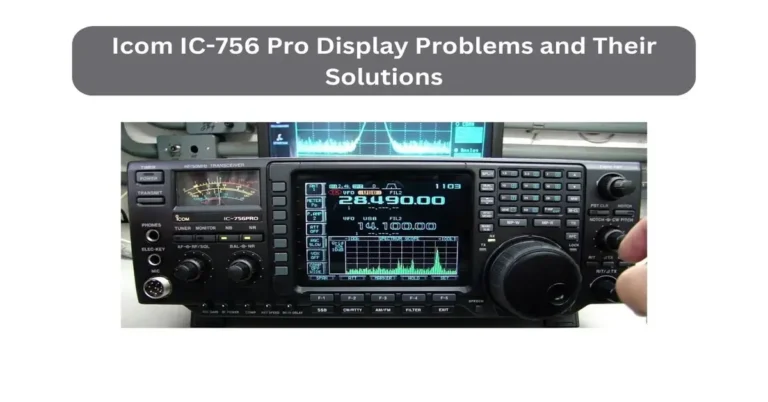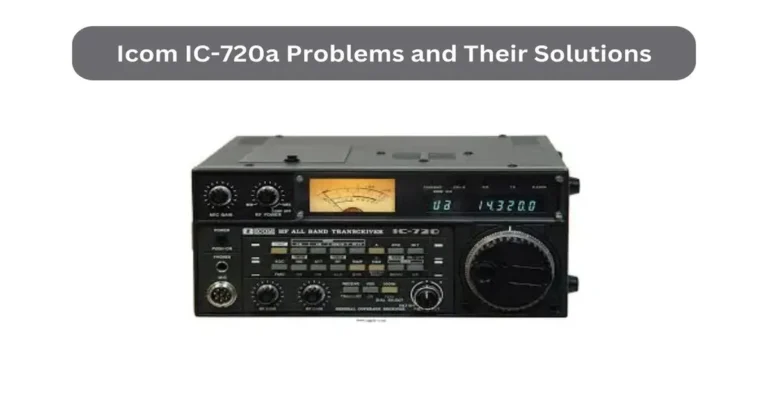6 Common Yaesu SM-5000 Problems and Possible Fixes
The Yaesu SM-5000 Station Monitor is an essential tool for amateur radio enthusiasts, providing real-time feedback on transmitted and received signals. Despite its reliability, the SM-5000 can encounter issues that can affect its performance. Understanding these common problems and knowing how to address them can ensure that your station monitor continues to function effectively.
In this blog, we will delve into six common problems faced by users of the Yaesu SM-5000 and offer detailed solutions to resolve them. Whether you’re dealing with a flickering display, inaccurate readings, or audio distortion, this guide is designed to help you troubleshoot and fix these issues. By the end of this article, you’ll have the knowledge needed to keep your SM-5000 in top condition.
Section 1: Display Not Powering On
One of the most frustrating issues that Yaesu SM-5000 users encounter is the display not powering on. This problem can stem from a variety of causes, often related to power supply issues or internal components. When your station monitor fails to turn on, it can halt your operations, making it crucial to diagnose and fix the problem quickly.
Possible Causes:
- The most common cause is a faulty power supply. If the power supply unit is damaged or not providing adequate voltage, the display will not turn on.
- Loose or damaged power connections are another frequent culprit. If the power cable is not securely connected or the wires are frayed, the unit may not receive the necessary power.
- Internal issues such as a blown fuse or a faulty power switch can also prevent the display from powering on.
Possible Fixes:
- Begin by checking the power connections. Ensure that the power cable is securely plugged into both the SM-5000 and the power source. Inspect the cable for any signs of damage, such as frayed wires or loose connectors. If the cable appears damaged, replacing it may solve the issue.
- Next, examine the power supply unit. Use a multimeter to check if the power supply is providing the correct voltage. If the power supply is faulty, it will need to be replaced.
- If the external power components are functioning correctly, the problem may lie within the unit itself. Open the SM-5000 and inspect the internal fuse. If the fuse is blown, replace it with one of the same rating. Additionally, check the power switch for any signs of damage or wear.
Read More: 5 Common Yaesu Dmu-2000 Problems and Possible Fixes
Section 2: Flickering or Unstable Display
A flickering or unstable display on the Yaesu SM-5000 is a common issue that can be both distracting and indicative of underlying problems. This issue can be caused by various factors, ranging from loose connections to aging internal components. If left unaddressed, it can worsen over time, leading to more significant damage.
Possible Causes:
- Loose internal connections are a leading cause of display flickering. If the internal cables or connectors are not securely attached, the display may intermittently lose connection, causing it to flicker.
- Aging components, particularly capacitors, can also contribute to an unstable display. Over time, capacitors may degrade, leading to power fluctuations that cause the display to flicker.
- External factors such as power surges or interference from other electronic devices can also cause the display to become unstable.
Possible Fixes:
- Start by checking all internal connections. Open the SM-5000 and ensure that all cables and connectors are securely attached. Pay particular attention to the connections between the power supply and the display. If any connections appear loose, reseating them may resolve the issue.
- Inspect the capacitors on the internal circuit board. Look for any signs of bulging or leakage, which indicate that the capacitor is failing. If you find any damaged capacitors, replacing them with new ones of the same rating can stabilize the display.
- To prevent external interference, ensure that the SM-5000 is not placed near other electronic devices that could cause electromagnetic interference. Additionally, consider using a surge protector to guard against power surges that could affect the display.
Read More: Yaesu Ft-857d Display Problems and Possible Fixes
Section 3: Inaccurate SWR and Power Readings
Accurate SWR (Standing Wave Ratio) and power readings are crucial for the effective operation of your Yaesu SM-5000. However, users often encounter issues where these readings become inaccurate, leading to potential problems with signal transmission. Inaccurate readings can be caused by several factors, including calibration issues, faulty connections, or problems with the antenna.
Possible Causes:
- Calibration drift is a common cause of inaccurate readings. Over time, the internal calibration of the SM-5000 may shift, leading to incorrect SWR and power measurements.
- Poor connections between the SM-5000, transceiver, and antenna can also result in inaccurate readings. If the cables are not properly connected or are damaged, the monitor may not receive accurate signals.
- Issues with the antenna itself, such as a poorly tuned or damaged antenna, can also affect the accuracy of the SWR and power readings.
Possible Fixes:
- Begin by recalibrating the SM-5000. Follow the calibration procedure outlined in the user manual to ensure that the monitor is correctly set up to measure SWR and power. Regular calibration checks can help maintain accuracy.
- Inspect the connections between the SM-5000, transceiver, and antenna. Ensure that all cables are securely connected and that the connectors are free from corrosion or damage. If any cables appear worn or frayed, replace them to ensure a solid connection.
- Check the antenna for any signs of damage or poor tuning. If the antenna is not properly tuned, it can cause incorrect SWR readings. Use an antenna analyzer to verify that the antenna is correctly tuned and make any necessary adjustments.
Read More: Yaesu Ft-1000mp Display Problems and Possible Fixes
Section 4: Audio Output Distortion
Distorted audio output from the Yaesu SM-5000 can significantly impact your listening experience, making it difficult to monitor transmissions accurately. Audio distortion can arise from several issues, including faulty audio components, interference, or even problems with the connected transceiver.
Possible Causes:
- Faulty audio components, such as capacitors or transistors, can lead to distorted sound. If these components degrade or fail, they can cause the audio signal to become unclear or garbled.
- RF (Radio Frequency) interference from nearby electronic devices or other radio equipment can also distort the audio output.
- Problems with the transceiver, such as incorrect settings or faulty connections, can affect the audio quality received by the SM-5000.
Possible Fixes:
- Begin by inspecting the internal audio components. Check the capacitors and transistors for any signs of damage or wear. If you identify any faulty components, replacing them with new ones of the same specifications can restore clear audio output.
- Reduce RF interference by repositioning the SM-5000 and any nearby electronic devices. Keep the monitor away from other equipment that could cause interference, such as computers, power supplies, or other radios. Additionally, using ferrite beads on the cables can help minimize interference.
- Verify that the transceiver settings are correct and that all connections between the transceiver and the SM-5000 are secure. If the transceiver is not correctly configured, it can send distorted signals to the SM-5000. Ensure that the audio levels and settings are properly adjusted.
Read More: Yaesu Vr-5000 Display Problems and Possible Fixes
Section 5: Issues with the Meter Needle Movement
The meter needle on the Yaesu SM-5000 is a critical component for monitoring signal strength and other parameters. However, users may encounter issues with the needle, such as it sticking, moving sluggishly, or not responding correctly. These problems can hinder your ability to monitor your station’s performance accurately.
Possible Causes:
- Dust or debris inside the meter mechanism can cause the needle to stick or move sluggishly. Over time, particles can accumulate, affecting the smooth movement of the needle.
- A misaligned or damaged meter needle can also cause it to move improperly. If the needle is bent or not properly seated, it may not respond accurately to signal changes.
- Electrical issues, such as faulty connections or components within the meter circuit, can cause the needle to behave erratically.
Possible Fixes:
- Start by cleaning the meter mechanism. Carefully open the SM-5000 and use a soft brush or compressed air to remove any dust or debris from the meter assembly. Ensure that the needle is free to move without obstruction.
- Inspect the meter needle for any signs of damage or misalignment. If the needle is bent, you may be able to straighten it gently. If it is not properly seated, carefully adjust it to ensure it moves freely.
- Check the electrical connections within the meter circuit. Ensure that all wires are securely connected and that there are no loose or corroded contacts. If any components appear damaged, replacing them can restore proper needle movement.
Read More: Most Common Yaesu MD-100 Problems and Possible Fixes
Section 6: Fan Noise and Overheating
Fan noise and overheating are common issues that can affect the performance of the Yaesu SM-5000, leading to potential long-term damage if not addressed promptly. The cooling fan inside the SM-5000 plays a crucial role in maintaining the unit’s temperature and preventing overheating of the internal components. However, over time, the fan may become noisy or fail to function correctly, leading to overheating and potentially causing damage to the unit.
Possible Causes:
- One of the primary causes of fan noise is wear and tear. Over time, the bearings in the fan can degrade, leading to increased noise as the fan struggles to maintain its normal operation.
- Dust and debris accumulation inside the unit can obstruct the fan blades, causing it to work harder and produce more noise. This buildup can also reduce airflow, contributing to overheating.
- Blocked ventilation vents or insufficient airflow around the unit can cause the SM-5000 to overheat, especially if the fan is not functioning at full capacity.
Possible Fixes:
- The first step in addressing fan noise is to clean the fan and the surrounding area. Carefully open the SM-5000 and use compressed air or a soft brush to remove any dust and debris from the fan blades and vents. Ensure that the fan can rotate freely without obstruction.
- If the fan is still noisy after cleaning, it may be time to replace it. Fans that have worn-out bearings or other internal issues often need to be replaced with a new unit of the same specifications. Replacing the fan can significantly reduce noise and improve cooling efficiency.
- Check the ventilation around the SM-5000. Ensure that the unit is placed in an area with adequate airflow and that the vents are not blocked by other equipment or objects. Improving ventilation can help reduce the risk of overheating.
- If overheating persists despite these measures, consider adding external cooling solutions, such as a small desk fan directed at the unit, to enhance airflow and keep temperatures in check.
Read More: 5 Common Yaesu Ft-1000MP Mark V Problems and Possible Fixes
Conclusion
Maintaining the performance of your Yaesu SM-5000 Station Monitor involves addressing common issues such as display problems, inaccurate readings, and overheating. By understanding these issues and applying the appropriate fixes, you can ensure that your station monitor remains a reliable part of your amateur radio setup. Regular maintenance, such as cleaning components, checking connections, and recalibrating the unit, is essential to prevent these problems from arising. Taking the time to troubleshoot and resolve any issues as they occur will not only extend the life of your SM-5000 but also enhance your overall radio experience. Keep your equipment in top condition, and it will continue to serve you well for years to come.






